#poisonous foods
Text
U.S. people, if you bought cinnamon from Dollar Tree, Dollar General, or other discount stores, throw it out. It's got lead
39K notes
·
View notes
Text
The Deadly Snail Pace of Food: More Fatal Than Cancer
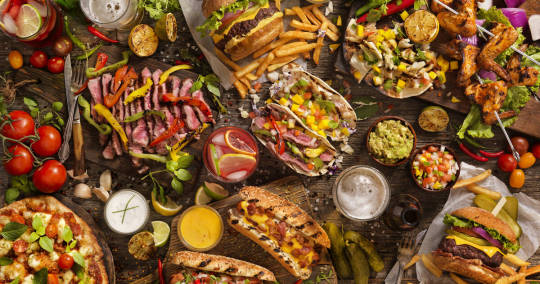
Food is a fundamental part of our daily lives, providing nourishment and sustenance. However, what if I told you that it is also the cause of more deaths than cancer? Yes, you read that right. Food is responsible for more fatalities than one of the most feared diseases in the world. This may come as a shock, as food is often associated with comfort and pleasure. But beneath its enticing facade lies a slow killer, silently taking lives at a snail's pace. In this blog post, we will delve into the dark side of food and explore the deadly consequences of its slow pace. Brace yourself for a startling revelation about the world's slowest serial killer: food.
Unmasking the World's Slowest Serial Killer: The Hidden Threat in Our Food
Food, the very thing that sustains us, has a dark side that often goes unnoticed. We consume it daily without a second thought, never suspecting that it may be the cause of more deaths than one of the most dreaded diseases in the world. It may seem impossible, but it's true. Food, in all its delectable forms, has the potential to be a slow serial killer.
The hidden threat lies in the toxins, contaminants, and bacteria that can infiltrate our food, lurking beneath its appetizing exterior. From harmful pesticides to deadly pathogens, our plates are sometimes laden with danger. What makes this threat even more insidious is its gradual, relentless nature. Unlike the immediate impact of diseases like cancer, food silently takes lives at a snail's pace, leaving its victims unaware until it's too late.
In this section, we will uncover the veil of innocence that shrouds our meals and expose the true face of this world's slowest serial killer. Prepare to be shocked as we explore the hidden threats lurking in our food.
Consuming Death One Bite at a Time: An In-depth Analysis of Food-related Deaths
Food-related deaths may seem like a rare occurrence, but the reality is far from that. Every year, countless lives are lost due to the hidden dangers lurking in our meals. From contaminated produce to contaminated meat, our food supply is riddled with hazards that can have fatal consequences. In this section, we will take a closer look at the different types of food-related deaths and the alarming statistics behind them.
One of the main culprits behind food-related deaths is foodborne illnesses. These illnesses can be caused by various bacteria, viruses, and parasites that contaminate our food. The symptoms may range from mild stomach discomfort to severe illness and, in some cases, death. Understanding the different types of foodborne illnesses and the ways in which they can be prevented is crucial in reducing the number of deaths caused by them.
Another factor that contributes to food-related deaths is the presence of toxins in our food. Pesticides, heavy metals, and other chemical contaminants can find their way into our meals and wreak havoc on our health. Over time, these toxins can accumulate in our bodies, leading to chronic illnesses and, in some cases, death.
By analyzing the various factors that contribute to food-related deaths, we can gain a better understanding of the magnitude of this issue and the steps we need to take to protect ourselves. From proper food handling and preparation to advocating for stricter food safety regulations, there are many ways in which we can prevent the consumption of death one bite at a time.
"Faster" Than Cancer: A Comparative Look at Food-borne Diseases and Cancer Fatalities
When we think of deadly diseases, cancer is often at the top of the list. However, what if I told you that food-borne diseases actually claim more lives than cancer? It may seem hard to believe, but the statistics don't lie. Food-borne diseases, caused by contaminated food, pose a greater threat to our health than cancer. While cancer can strike quickly and aggressively, food-borne illnesses have a slower, more insidious impact.
What makes this comparison even more startling is that food-borne diseases are preventable. By practicing proper food safety measures, such as washing hands, cooking food thoroughly, and storing it correctly, we can significantly reduce the risk of falling victim to this silent killer. The key is awareness and education.
In this section, we will delve into the numbers and explore the stark reality of food-borne diseases compared to cancer fatalities. Prepare to be shocked by the alarming statistics that highlight the true extent of this hidden danger.
youtube
Prevention is Better Than Cure: Ways to Protect Ourselves From The Silent Killer
When it comes to the silent killer that lurks in our food, prevention is truly better than cure. While it may seem daunting to think about all the potential dangers that could be hidden in our meals, there are steps we can take to protect ourselves and minimize the risk.
First and foremost, proper food handling and preparation are key. Washing fruits and vegetables thoroughly, cooking meats to the appropriate temperature, and avoiding cross-contamination can go a long way in preventing foodborne illnesses.
Another important aspect of prevention is staying informed. Keeping up-to-date with food recalls and safety alerts can help us avoid consuming potentially hazardous foods. Additionally, staying educated on the proper storage and expiration dates of food products can further reduce the risk of contamination.
Advocating for stricter food safety regulations is also crucial in preventing the silent killer. By supporting policies that ensure proper food inspection, labeling, and enforcement, we can hold food manufacturers and suppliers accountable for providing safe products.
In conclusion, protecting ourselves from the hidden threat in our food requires a proactive approach. By practicing safe food handling, staying informed, and advocating for stricter regulations, we can minimize the risk of falling victim to the slowest serial killer: our meals.
#food#killer foods#foods#food kills#dangerous foods#junk food#foods that can kill you#dangerous food#foods that kill#processed food#foods that kill you#among us kills fast food chains#fast food#foods that have killed#deadliest foods#poisonous foods#kills#deadly food#processed foods are killing us#deadliest food#deadly foods#exotic foods#foods that could kill#healthy foods#foods to avoid#food documentary#documentary food#Youtube
1 note
·
View note
Text

[ x ]
#enough heartbreak guys time to be happy#tho now that i think of it... it's really sad if that post was trey visiting restaurant jade works at while they never exactly be together#or trey is married to someone else; and when he got dementia even tho he didn't remember the wife he married anymore he still remembers jad#and was taken there to visit his restaurant again; or jade was called to deliver food to the aged care trey was at#augh...... also if anyone wants more clarification jade eating his own poison is implying he ended his own life#lmao what am i saying on this happy post let's get to tagging#twst#twisted wonderland#treyjade#trey clover#jade leech#fanart
2K notes
·
View notes
Text
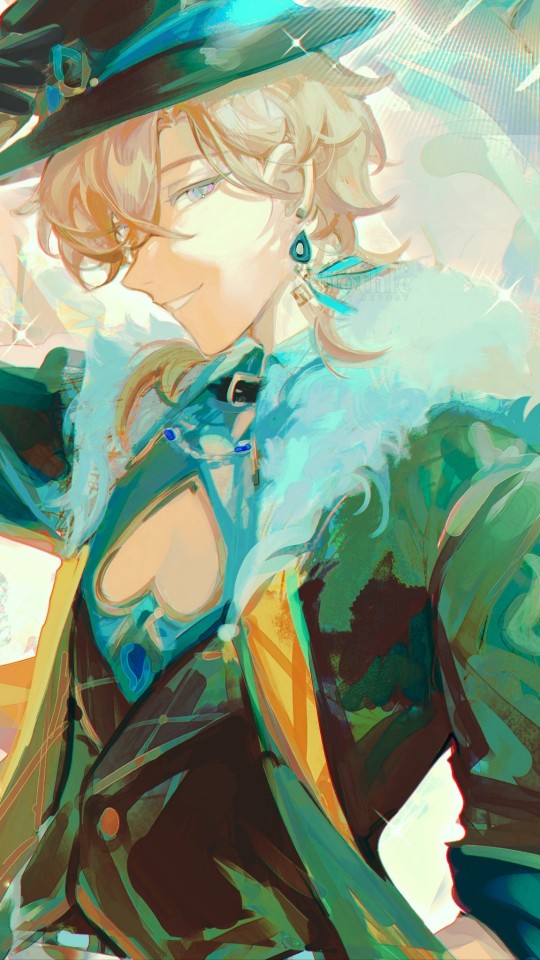
I heard it's riney's birthday...🦚🎉
#aventurine#hsr aventurine#honkai star rail#hsr fanart#aventurine fanart#fanart#art#congratulations aventurine for being the only hsr character with canon birthday#i painted this while suffering from food poisoning so it's very messy😭#anything for aventurine though food poisoning will not stop me drawing him#my art
3K notes
·
View notes
Text
#forgot to set the timer for a week. ah well. short lived seafood poll#ive gotten food poisoning from salmon twice and i still love it somehow#i love oysters and all sorts of mollusc and shellfish and raw fish and cephalopods too. gimme
5K notes
·
View notes
Text
[Robin!Dick era]
Bruce: Dick has three aunts. He calls them Aunt Cupcake, Aunt Flower, and Aunt Kate.
Bruce: Time to step up your game, Kate.
#source: twitter#bruce wayne#batman#dick grayson#nightwing#robin#kate kane#batwoman#harley quinn#pamela isley#poison ivy#gotham city sirens#gotham rogues#batfamily#batfam#batboys#batbros#batkids#batsiblings#batman family#incorrect batfamily quotes#incorrect quotes#incorrect dc quotes#dc comics#tw food mention
2K notes
·
View notes
Text


sneaking in at twelve with Sleek!
Another more domestic breed, these deathclaws are indiscriminate with dietary requirements and often need to be penned behind electric fencing - they'll tip regular fences with their bulk trying to break into farmland and cold storage.
#i got this and one more to finish which im late with on account of food poisoning w lingering gastric distress involving urgent care oopsiee#i got bullied into making this one a blue tongue skink#deathclaw#deathclaugust#fallout#fallout 4#kullen art
734 notes
·
View notes
Text

It's my birthday!!! ᕕ( ᐛ )ᕗ🎂
#it's my first time here! hello everybody!!! *waves excitedly*#sun thinks setting the cake on fire gets extra style points#he's not wrong though#despite his teasing Moon does help y/n hide the leftovers when sun's not looking#can't bully y/n if they're sick in bed with food poisoning#fnaf security breach#fnaf sb#DCA#dca fandom#sundrop x reader#moondrop x reader#y/n#my art
3K notes
·
View notes
Text


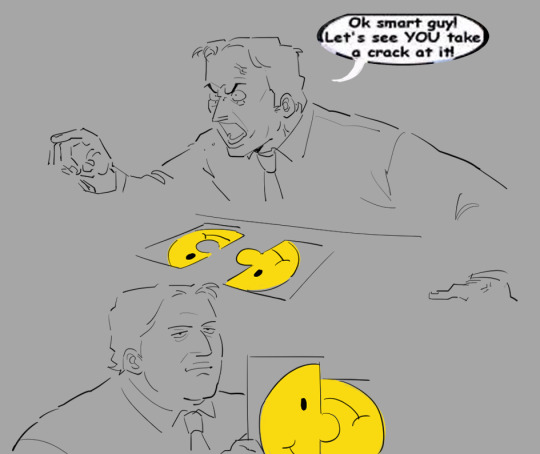


back on the grind
#saw#saw movie#saw franchise#saw fanart#peter strahm#mark hoffman#hoffstrahm#coffinshipping#art tag#finally not sick after having a cold one week and food poisoning the next#back to lighting matches near open gas stove tops
1K notes
·
View notes
Text
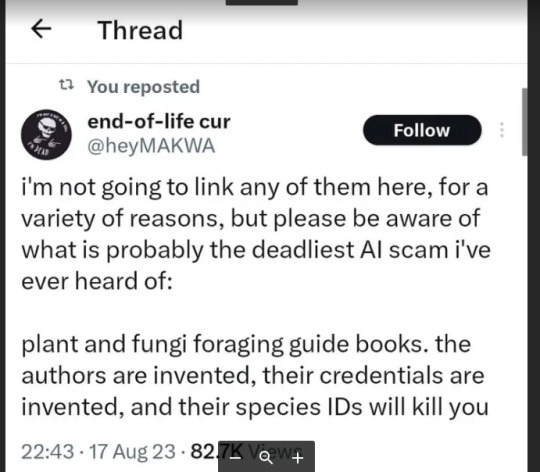
ETA: I wrote up a guide on clues that a foraging book was written by AI here!
[Original Tweet source here.]
[RANT AHEAD]
Okay, yeah. This is a very, very, very bad idea. I understand that there is a certain flavor of techbro who has ABSOLUTELY zero problem with this because "AI is the future, bro", and we're supposed to be reading their articles on how to use AI for side hustles and all that.
I get that ID apps have played into people's tendency to want quick and easy answers to everything (I'm not totally opposed to apps, but please read about how an app does not a Master Naturalist make.) But nature identification is serious stuff, ESPECIALLY when you are trying to identify whether something is safe to eat, handle, etc. You have to be absolutely, completely, 100000% sure of your ID, and then you ALSO have to absolutely verify that it is safely handled and consumed by humans.
As a foraging instructor, I cannot emphasize this enough. My classes, which are intended for a general audience, are very heavy on identification skills for this very reason. I have had (a small subsection of) students complain that I wasn't just spending 2-3 hours listing off bunches of edible plants and fungi, and honestly? They can complain all they want. I am doing MY due diligence to make very sure that the people who take my classes are prepared to go out and start identifying species and then figure out their edibility or lack thereof.
Because it isn't enough to be able to say "Oh, that's a dandelion, and I think this might be an oyster mushroom." It's also not enough to say "Well, such-and-such app says this is Queen Anne's lace and not poison hemlock." You HAVE to have incredibly keen observational skills. You HAVE to be patient enough to take thorough observations and run them through multiple forms of verification (field guides, websites, apps, other foragers/naturalists) to make sure you have a rock-solid identification. And then you ALSO have to be willing to read through multiple sources (NOT just Wikipedia) to determine whether that species is safely consumed by humans, and if so if it needs to be prepared in a particular way or if there are inedible/toxic parts that need to be removed.
AND--this phenomenon of AI-generated crapola emphasizes the fact that in addition to all of the above, you HAVE to have critical thinking skills when it comes to assessing your sources. Just because something is printed on a page doesn't mean it's true. You need to look at the quality of the information being presented. You need to look at the author's sources. You need to compare what this person is saying to other books and resources out there, and make sure there's a consensus.
You also need to look at the author themselves and make absolutely sure they are a real person. Find their website. Find their bio. Find their social media. Find any other manners in which they interact with the world, ESPECIALLY outside of the internet. Contact them. Ask questions. Don't be a jerk about it, because we're just people, but do at least make sure that a book you're interested in buying is by a real person. I guarantee you those of us who are serious about teaching this stuff and who are internet-savvy are going to make it very easy to find who we are (within reason), what we're doing, and why.
Because the OP in that Tweet is absolutely right--people are going to get seriously ill or dead if they try using AI-generated field guides. We have such a wealth of information, both on paper/pixels and in the brains of active, experienced foragers, that we can easily learn from the mistakes of people in the past who got poisoned, and avoid their fate. But it does mean that you MUST have the will and ability to be impeccably thorough in your research--and when in doubt, throw it out.
My inbox is always open. I'm easier caught via email than here, but I will answer. You can always ask me stuff about foraging, about nature identification, etc. And if there's a foraging instructor/author/etc. with a website, chances are they're also going to be more than willing to answer questions. I am happy to direct you to online groups on Facebook and elsewhere where you have a whole slew of people to compare notes with. I want people's foraging to be SAFE and FUN. And AI-generated books aren't the way to make that happen.
#foraging#mushroom foraging#plant foraging#mushrooms#edible plants#edible mushrooms#wild foods#food#nature#AI#fungus#fungi#poisonous mushrooms#poisonous plants#botany#mycology#rant
4K notes
·
View notes
Text


Hii have some sniperscout angst I drew as a gift for my friend lenny
#i've been sick from food or gas poisoning on the valentine's day so I couldn't draw anything today sorry. have some old art#i love when sniper pushes people away from him. and scout torture of course#team fortress 2#team fortress 2 fanart#tf2#tf2 fanart#tf2 scout#tf2 sniper#speeding bullet#sniperscout
1K notes
·
View notes
Text


" now, open your mouth & take the remedy ... "

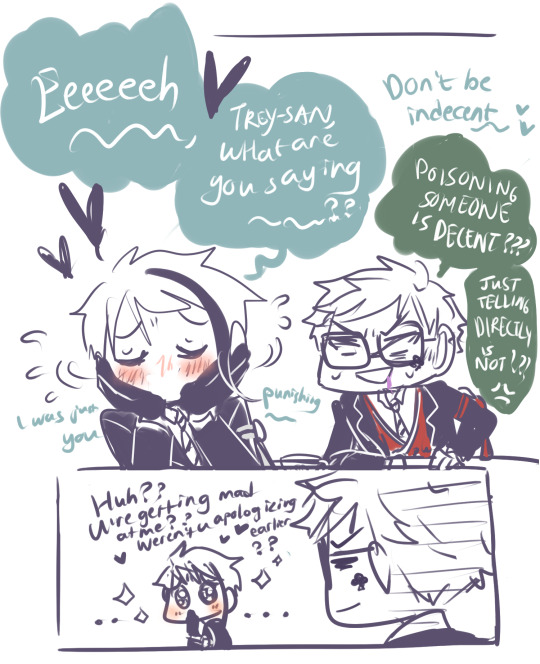
[ ... ah i am also hopeless for choosing to be with this dangerous kind of guy ... ] [x]
- sequel to [x]
#twisted wonderland#twst#treyjade#trey clover#jade leech#fanart#trey who can notice poison in jade's food and counter his attack is cool#but i also want to see jade caught trey off guard and winning for once#no one really telling me i totally forget trey's clover face paint
1K notes
·
View notes
Text
hickey's knife super interesting for obvious reasons, but also have you guys ever see some of the other knifes that got fashioned / salvaged from the wrecks.... especially the inuit-made ones....

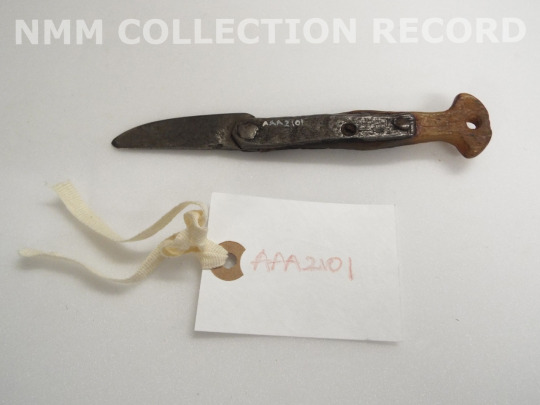










like these are very beautiful to MEEEEE
#especially the ulu knife being made from a recycled goldner tin...... i could cry....#native tool to skin animals/slice food into portions being crafted from the metal that held poisoned sour food that killed the imperialists#i need to double over and take a fucking breather here dude are you KIDDING MEEEE#📜
1K notes
·
View notes
Text
Wei Wuxian: Lan Zhan! Our son is giving me /such/ an attitude right now!
Lan Wangji: *comes into the tea room to see WWX and LSZ at the table* Hm? 😐
Lan Sizhui: 0.0 *big eyes and pouting because he’s literally not doing anything wrong* ??? 🥺
Lan Wangji: *turns to WWX* Hm? 🤔
Wei Wuxian: *picks up an annoyed looking rabbit from the floor* Look at this little monster, he’s thumping his legs at me because I won’t give him my food! This is human food! It’s cooked!
Lan Sizhui: *giggling* 🤭
Lan Wangji: *soft eyes of love and affectionate blinks* Mm. 🥰 Entitled.
Bunny: *angry thump at WWX as soon as he’s set down* 😡🐰
#the grandmaster of demonic cultivation#the untamed#mdzs#incorrect mdzs#incorrect untamed quotes#wei wuxian#lan wangji#wangxian#lan sizhui#Sizhui has a new brother lol#little mister is absolutely demanding some of WWX’s poisoned food lmao
677 notes
·
View notes
Text

☁️
#dungeon meshi#farcille#falin touden#marcille donato#my art#marcilles outfit based off the panel where laios gets food poisoning#delicious in dungeon
638 notes
·
View notes
Text


Screamer, colored!
Its grounded posture and unusual concave neck and horns provide it the means to echo its sounds an incredible distance. By rapidly expanding and collapsing its vocal sacs it can imitate gunfire at such a decibel that it ruptures eardrums at close range.
#deathclaugust#hi i got food poisoning and it's been a task and a half to recover. let alone draw new guys u_u#deathclaw#fallout#fallout 4#kullen art
1K notes
·
View notes